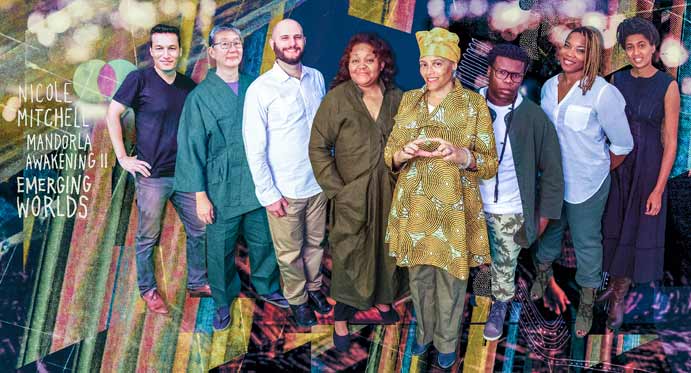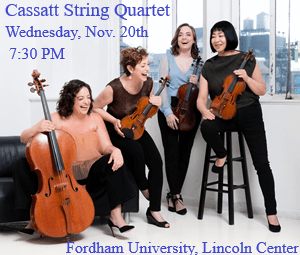Composer, flutist, bandleader, and educator Nicole Mitchell is a Professor of Music in the Integrated Composition, Improvisation, and Technology program at the University of California, Irvine. She has deep musical roots in Chicago where she served as the first woman president of the Association for the Advancement of Creative Musicians (AACM), and has been a member since 1995. We spoke with her on the eve of the release of her new Black Earth Ensemble album Mandorla Awakening II: Emerging Worlds, the third in a series of albums on Afrofuturism themes.
What is the genesis of your enduring fascination with Afrofuturism?
Afrofuturism was a bit of an inheritance, as my mom was a self-taught artist who made paintings of Black women holding their babies on distant planets and my dad was a Trekkie fan who was convinced he saw a UFO and believed in extraterrestrials. These ideas haunted my dreams as a child. There were also lots of sci-fi books in the house, and Octavia Butler was a favorite read for my mom. When I moved to Chicago, I worked over ten years at Third World Press, the oldest African American book publisher in the U.S. When reading through manuscripts I realized that there are three types of work made by Black artists: Historical (the past), Now (focused on a critique or description of our present moment), and Visionary (looking towards the future). I wanted to create visionary worlds through music. I’ve realized that Afrofuturism is a great vehicle to ask questions about society in a way that people are willing to imagine, and sci-fi is a great way for audiences to encounter creative music, because their minds are more open. I feel our imaginations are underutilized, and I try to create alternative worlds through music.
How did the ideas of Mandorla Awakening evolve?
Mandorla Awakening, my novella that is the core platform that inspired the music, starts from the questions: “What would a technologically advanced society that is also in tune with nature be like? How do we make real progress? How do we advance coexistence?” Clearly, we have not made real progress, because human beings are one organism and that organism is trying to kill itself. We still treat each other as badly as we did thousands of years ago. I would love to write a book on this. I’d also like to see the musical expression of Mandorla Awakening grow beyond music, to reach more people. What would it be like to bring an international group of experts of many disciplines together — green architects, progressive psychologists, and social ecologists, environmental scientists, city managers, economists, fiction writers, humanitarians and others — to figure out our next steps towards co-existence. That would be amazing.
What has been the role of AACM in the development of American music?
Mandorla Awakening II was premiered at Chicago’s Museum of Contemporary Art to celebrate the 50th anniversary of AACM. What’s most special to me about AACM is that people of like minds come together and challenge each other, inspire each other, and support each other to achieve their artistic aims, despite having radically different ideas. That’s why AACM has created such a great diversity of mind-blowing music and it has persisted for so long. The core mantra for AACM is “create original music.” Many AACM artists embrace both experimentation and expanding the legacy of African American cultural creativity, while taking inspiration from a wide range of cultures and traditions from around the globe. Many have different aesthetic concerns, but we are there to support each other.

Nicole Mitchell’s Black Earth Ensemble (photo by Michael Jackson)
What are the aesthetic underpinnings of your Black Earth Ensemble?
Black Earth Ensemble was my first platform for compositions and performance. I’m so excited that 2018 will be our 20th anniversary! The group is a chamber ensemble with 10 or fewer players, but it’s like a large family with many long term members that fluctuates, depending on the project. The group is always a mix of feminine and masculine, intergenerational, and expresses a wide emotional and aesthetic pallet ranging from funk, blues, contemporary music, free improvisation and more. I consider it a celebration of contemporary African American culture. I hope people notice that for Mandorla Awakening, half of the ensemble is Black women. With my music I try to bridge the familiar with the unknown and lately I’ve been really interested in creating music inspired by narratives and also doing trans-disciplinary projects (with video and/or dance). I just did a project featuring poetry by Gwendolyn Brooks, the first African American Pulitzer Prize winner, and later this year we will release a new CD of music featuring distinguished poet Haki R. Madhubuti. In June, vocalist/composer Lisa E. Harris and I will premiere EarthSeed, a new work inspired by Octavia Butler and commissioned by the Art Institute of Chicago.
How have you structured the music of Mandorla Awakening?
The score for Mandorla Awakening is a mix of traditional notation and graphic score, while integrating improvisation. I felt a need to simplify my writing because I felt I’ve been over-composing. I’m trying to not get overly complex because I want to be able to make space for the individual voice and authenticity of each player. The composed elements and the improvised elements are fully braided together, intertwined. At any point in the piece, some musicians will be playing notated sections while others are improvising. And there could be new notated musical material introduced while players are still improvising on the prior material. The improvisation is guided. For example, a player may have only five notes to use but can choose the order, the dynamics and rhythmical phrasing, so they make a choice as to their contribution. Also, we had lots of conversations in rehearsals to make sense of the score. I want to expand the possibilities of dialogues between the players without over-controlling it. The composer sets up the possibilities, the performers make the choices.
Upcoming:
May 5, 2017: Mandorla Awakening II: Emerging Worlds album release on FPE Records.
June 10, 2017: Ojai Music Festival Daybreak Concert. Engraved in the Wind (American Premiere), They Witnessed an Unfolding (World Premiere), Inescapable Spiral (World Premiere), with International Contemporary Ensemble, dancer/choreographer Irishia Hubbard, and UC Irvine Creative Music Ensemble.






















